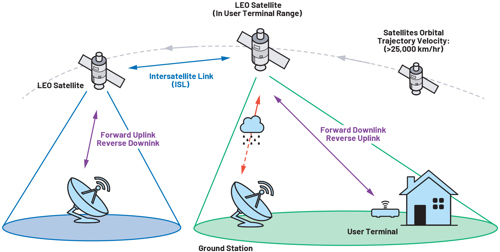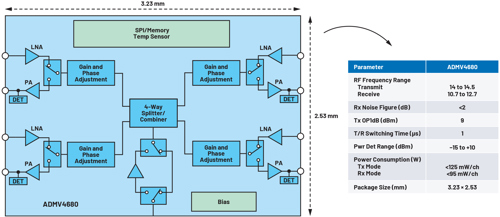A new wave of high-speed internet connectivity is planned around LEO satellite constellations that will deliver low latency, high-capacity broadband connectivity for next-generation internet communications and LEO satellites will play an important role in the continuing rollout of 5G cellular connectivity.
Satellite networks are also becoming more involved in 3GPP standardisation with activities kicked off within the 3GPP standards body back in 2017 to understand the feasibility of satcom networks within 5G connectivity. Through releases 15, 16, 17, and 18 of the 3GPP standard, several activities were developed to support the integration of these networks.

LEO satellites can provide wide area coverage to underserved areas, provide continuity of service for people on the move, connect to machine-to-machine (M2M)/Internet of Things (IoT) devices, and be a notable upgrade path for 5G in a cost-effective manner.
The next generation of LEO systems will orbit between 500 km and 2000 km above the Earth’s surface and will deliver a technically superior solution. Their close proximity to the Earth means they will deliver lower latency connections, approximately 50 ms of latency (and this will improve with next-generation technology to <20 ms) vs., for example, GEO that is 700 ms.
A key enabler of LEO satellites is that their exposure to radiation is much lower due to the lower orbit which means that prohibitive radiation hardened testing can be relaxed, and less radiation means wider availability of semiconductor processes and, therefore, components for use.
Given the lower orbit, the expectation is for a much larger number of satellites deployed. The average life span for such satellites will be much shorter than previous use cases; perhaps between 5 and 8 years, after which these satellites will fall out of orbit and need to be replaced. LEO satellites must be cost-effective to launch and relaunch replacements.
All these trends are making industry watchdogs take note as the LEO broadband connectivity business case is starting to look strong.
At the time of writing, it is expected that users could achieve maximum downlink data speeds of 100 Mbps and this could extend to 150 Mbps in the future, which is ideal for multi-user, full-time video streaming.
One challenge with LEO is the ever-moving nature of satellites - the constellation really needs to be fully deployed to become a minimal viable service. This means that the initial outlay is high as the number of LEO satellites is greater given their lower orbit.
How does it work?
The LEO satcom systems are made up of three major components. There are the User Terminals/User Equipment (UE), which provide the direct link between the user and the satellite and tend to be low cost, easy to setup terminals located in homes, but can also be mobile terminals. User terminals leverage high levels of IC integration to simplify the bill of materials (BOM), lower cost, and maintain a small form factor.
Ground Stations or Gateways are the ground connections to the servers typically over fibre, and they link the satellite to the ground. They are deployed at fixed locations across the Earth.
Finally, there are satellite constellations and these orbit the Earth providing simultaneous links to connect both terminals and gateways.
LEO satellites move across space and typically a single satellite will orbit the Earth in a period of 90 mins to 110 mins, referred to as the orbital period. Because of this, a user connecting to the satellite will only be in range of that satellite for a short period of time (up to 20 mins). So, the average user will be connecting to multiple satellites during normal operation.
Consequently, users must be handed off to other satellites that come into range, in a similar manner to a person using a cell phone in a moving car and one base station in the cellular network handing off to another. This places strict requirements on how to steer the beams to maintain the best link to the most appropriate satellite.
Another interesting evolution is how a satellite system maintains operation when it is out of range of a ground station. Traditionally, satellites use bent pipe, which means the satellite must always find a link path to the Earth or some other means (aircraft) to serve as a hop back to another satellite in space, which could then be in range of a ground station.
A new technique is through intersatellite links using optical or V and E band connections in space to link satellites.
User terminals are driving significant levels of IC integration and solutions require the highest level of IC integration to enable the smallest form factor radio terminal, while maintaining the lowest power consumption and a strict adherence to the optimal cost per radio.
Up/downconverters (UDCs) are a foundational product in user terminals, and they interface the modem IF or baseband information directly to the Ku band or Ka band.
Downlink and uplink are separated in frequency so the communication from the satellite to the user terminal is using two separate frequency bands, therefore, RFIC companies must design each user terminal up and down converter for separate bands.
Depending on uplink vs. downlink, user terminal links typically cover channel bandwidths (BW) of 125 MHz to 250 MHz and gateways cover between 250 MHz and 500 MHz. However, some deployments have a shared bandwidth capability, so the channel bandwidth is reconfigurable in the frequencies they operate.
LEO satellites are moving constantly, so the up/downconverter frequency synthesiser within the terminal must achieve fast lock times for uninterrupted connection.
Synthesisers are used to assist in the frequency upconversion and downconversion and play a vital role in enabling the terminal to connect and reconnect to different satellites during operation, as the frequency over the air changes constantly within the operational bands from one satellite to another.
ADI, for example, has developed a family of Ku and Ka band UDCs targeting user terminals to address the size, weight, area, power, and cost (SWaP-C) problem. They contain extensive RF and IF signal conditioning such as filters, amplifiers, attenuators, PLLVCOs, and power detection.
All ICs are purposely designed with the signal chain performance of a user terminal in mind. The ADMV4630/ADMV4640 are Ku band UDCs that support an IF interface to the satellite modem, while the ADMV4530/ADMV4540 UDCs have been developed to support satcom modems requiring an I/Q baseband interface.
Higher Performance Terminal UDCs
Some applications within the terminal market are performance driven and have less restrictions on their size and lowest cost design goals. They have the freedom to use discrete RFIC solutions. Keeping components in separate packages allows for a mixture of process technology including MESFET, pHEMT, BiCMOS, and CMOS ICs to optimise any design requirement.
Discrete design allows for many types of performance vs. size trade-offs, giving maximum flexibility in the design process. Designers can create higher performance radios giving higher output power and supporting wider bandwidths. Furthermore, a higher receiver sensitivity to improve dynamic range and improved spurious performance can be achieved. It should be noted that ground stations/gateways also fall into this category of solutions.
Gateways are larger in size and certainly not driven by the same integration demands at the terminal level. They leverage different process technology to bring the most performance-optimised solution to the market.
Steerable Antennas
A growing number of companies are focusing on lowering the cost of deployment of user terminals by removing the expensive installation cost traditionally associated with a professional contractor who mounts the equipment and locates the satellite position.
This is achieved by combining the antenna along with all the electronics required to process the communication link in a single outdoor unit (ODU). The ODU is the antenna array that resides outside the home and is aimed at the sky. An indoor unit (IDU) is connected to the ODU and functions as a traditional router (wired or wireless) to supply internet connectivity to the user.
As mentioned earlier, LEO constellations will have many satellites that move in and out of the ground terminal field of view so it’s far more efficient to use the electronic steerable antenna (ESA) as it can enable high directivity by electronically steering the transmit and receive beam of energy in the direction of the satellite. Thereby, the best link is maintained from one satellite to another with near instantaneous switching between satellites. In fact, the ESA is almost a requirement when you think of the orbital period and the number of satellites that need to be connected to during the normal course of operation.
To address this challenge, ADI has developed the Ku band beam forming integrated circuit (BFIC) technology. The ADMV4680 is a silicon solution designed for user terminals, allowing for half-duplex channels to independently control the gain and phase of the signal.
What is remarkable is that the size of this IC is only 8.2 mm2, as shown in the figure below.

The core to the development of BFIC technology to minimise overall radio cost is system and array expertise. Mechanical assembly and PCB design, which includes stack up and number of layers, are part of the radio cost driver. When the BFIC is developed with the mechanical and PCB designs in mind, a minimum overall radio cost is created.
Adopting the ESA to both track the LEO satellites and optimise the link speed allows for low-cost setup and typically these are plug and play. The ESA and the migration to more integrated ODUs are radically simplifying the deployment and lowering the cost of the system. The ESA is also enabling a flatter panel and aesthetically pleasing designs.
It’s worth noting that in the case of highest performance terminal applications, a dual parabolic steered antenna is used. In these cases, cost and aesthetics are not a primary driver and overall performance is the focus. When it comes to consumer and cost-conscious small enterprise solutions, ESA is by far the best way to achieve the lowest radio cost while meeting system design goals.
Conclusion
LEO internet connectivity is a new and exciting domain and the race for space is on the minds of most governments and internet providers. As the world continues to become more connected, LEO will play an important role in 5G by further enhancing the connectivity of the 3GPP standard from space to rural locations. While RFIC integration requirement on user terminals is becoming more challenging companies like ADI are continuing to develop solutions and create roadmap ICs in this domain.
Author details: Donal McCarthy, Director of Marketing and Business Development, Analog Devices













